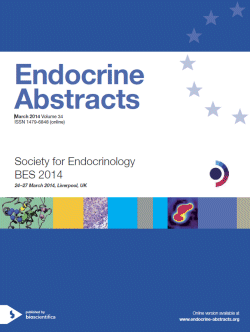Searchable abstracts of presentations at key conferences in endocrinology
Symposia
Fat and bone ‐ old neighbours, new relationships? (Supported by <emphasis role="italic">Endocrine Connections</emphasis>)
ea0034s10.1 | Fat and bone ‐ old neighbours, new relationships? (Supported by <emphasis role="italic">Endocrine Connections</emphasis>) | SFEBES2014
Fat and its influence on bone
In general, higher body weight in adults is associated with higher bone mineral density and is protective against fracture, but may be associated with an increased risk of some fractures. Possible mechanisms for higher bone density include mechanostat response to increased loading and increased oestrogen production by adipocyte aromatase.It has been increasingly recognised that bone interacts with other organs and tissues (such as fat, the gastrointestin...
ea0034s10.2 | Fat and bone ‐ old neighbours, new relationships? (Supported by <emphasis role="italic">Endocrine Connections</emphasis>) | SFEBES2014
Obesity and fractures: what is the relationship?
Until recently obesity was believed to be protective against fractures as a result of higher bone mass and the cushioning effect of subcutaneous tissue during falls. However, recent studies indicate that fractures in obese postmenopausal women and older men make a substantial contribution to the overall fracture burden in this population. The effect of obesity on fracture risk is site-dependent, with some protection against hip and wrist fractures but increased risk of ankle a...
ea0034s10.3 | Fat and bone ‐ old neighbours, new relationships? (Supported by <emphasis role="italic">Endocrine Connections</emphasis>) | SFEBES2014
Energy deficiency, amenorrhea and the skeleton: challenges and therapies
The physiological adaptations associated with energy deficiency contribute to menstrual cycle disturbances. The downstream effects of both energy deficiency and hypoestrogenism synergistically impair bone health, leading to low bone mineral density, compromised bone structure and microarchitecture, and ultimately, a decrease in bone strength. Low bone mineral density is frequently observed among exercising women and anorexic women with functional hypothalamic amenorrhea (FHA) ...




